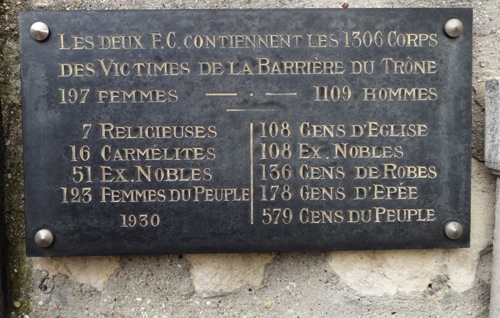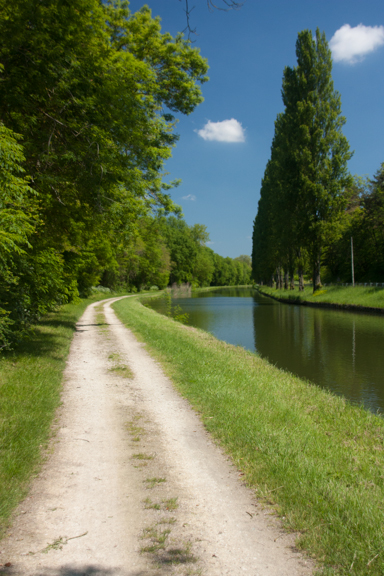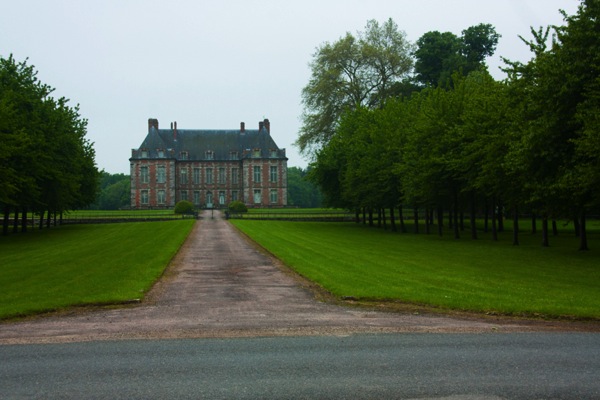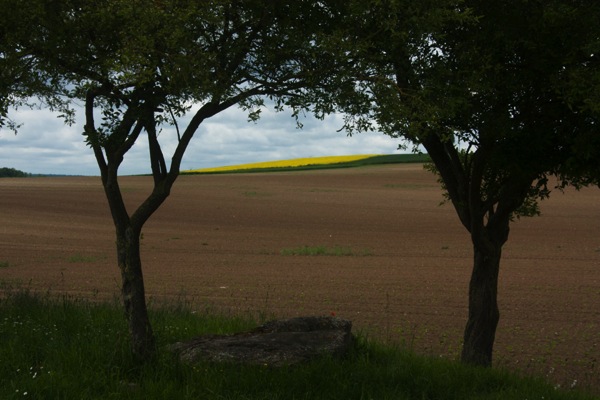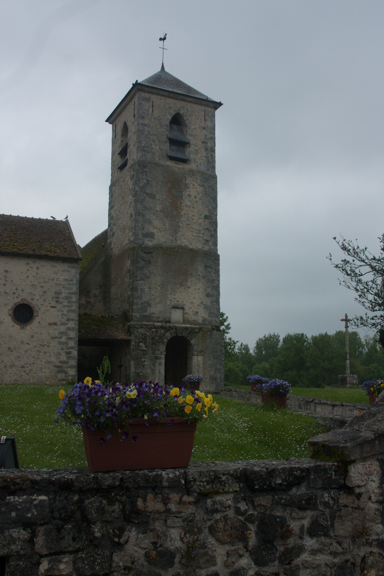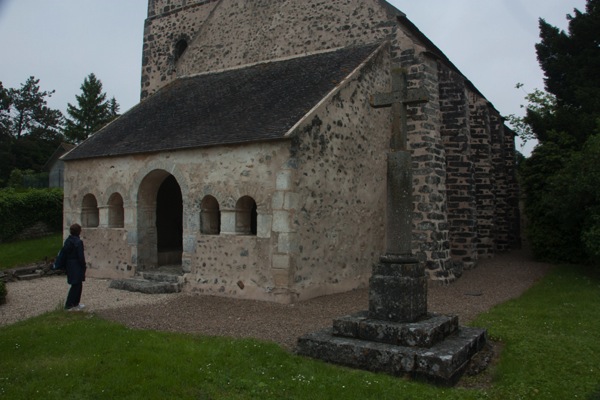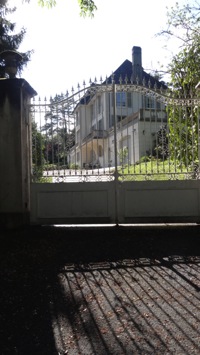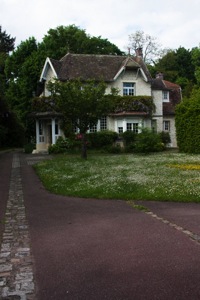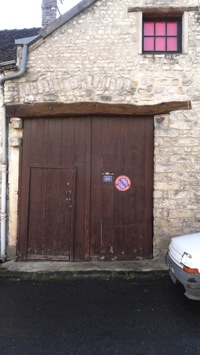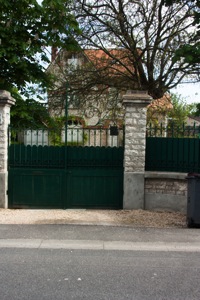Note: this was Saturday, May 19 – little late posting this because of the delay in getting connected.
We tried to walk around today, really we did. But though the temperature wasn’t too bad – somewhere around 55 – the 30 mph wind and rain did us in. So we just took a drive through the country-side and visited a couple small towns. We ended in the town of Larchant, which rewarded us with a most unusual church to visit.
I think most Americans, when they think about France, think,”Paris, big city.” Paris is, indeed, a big city and there are other big cities in France, but much of France is beautifully rural. Our drive today took us through miles and miles of farmlands, and a number of villages. The views were just beautiful: many fields are planted in rape-seed – grown for its oil – which are now in bloom. These fields are a brilliant yellow. Many fields are a deep green (don’t know what’s planted there), and others are fallow: plowed but not planted. So the vistas are miles and miles of bright yellow, deep green and dark brown fields, interspersed with small copses of trees.
France is a country of villages. I’d guess that if I drew a circle on the map 15 miles across and centered on Montigny, that circle would capture more than 150 villages with less than 1,500 people in each. These villages have existed forever and, if they now have traffic signs and cars, mostly they look as they have for hundreds of years.
In our drive, I saw a sign pointing to Larchant. We have an excellent book on France titled the “France – A Phaidon Cultural Guide” which details every small cultural detail of the slightest interest throughout France. I had read the entry for Larchant, as it is not too far from us, and remembered that it’s thought that a Saint Mathurin was born there in the third century. Whether he was born there or not, in the Middle Ages a church was built on top of his funerary chapel and became a pilgrimage destination. As Laurie and I are fascinated with pilgrimages (not that we’ve ever been on one), I pointed the car toward Larchant.
The Phaidon guide said about the church in Larchant that the tower had fallen down in the 17th century (right – more or less four hundred years ago). It didn’t mention that the entire church had pretty much fallen into ruins and that, in 1983, a twenty-year effort to restore it began. (Phaidon was published in 1975, before the restoration started.) Much of the church, including the tower, was too far gone to restore, but about a third of the nave, the transept and the choir have all been restored (less part of the roof, which has a wood ceiling now where once it was stone). This church was really big for such a small town (the power of a pilgrimage), and the restored part is, simply stated, beautiful. As much as possible, original materials were recovered from the rubble of the ruins and used, and where that was not possible, stone matching the original stone was quarried and worked as a thousand years ago. Stained glass windows, long gone, were restored with modern stained glass, in modern patterns.
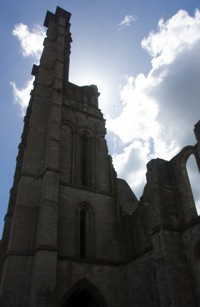 |
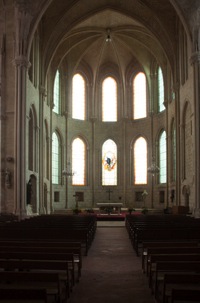 |
I have no idea how much it cost to restore the Iglise Saint-Mathurin, but I am glad it was done. The church is light and beautiful and gives a sense of how it must have been when a pilgrim arrived after walking hundreds of miles.
By the way, Saint Mathurin is said to have been a healer of madness. We offered up a few prayers for folks we know dealing with that dark problem. Who knows? Maybe Saint Mathurin still has a bit of power to help. And given the rain here, we may need some of that help ourselves soon.
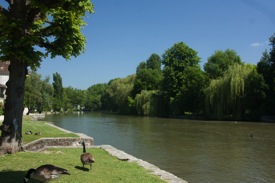
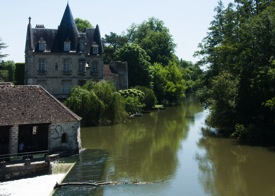
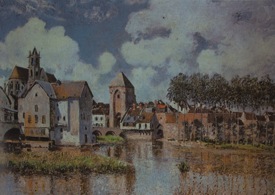
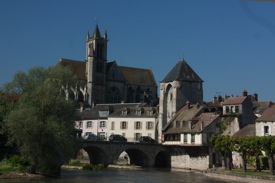
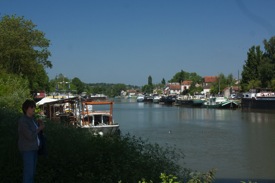 Laurie and the Loing River
Laurie and the Loing River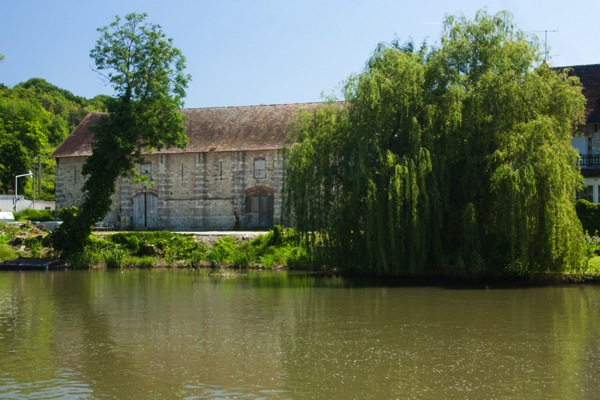 Mostly, I love the willow tree.
Mostly, I love the willow tree. I could live here…
I could live here…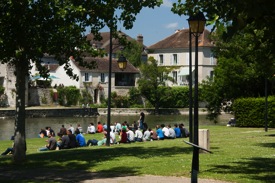 We weren’t the only ones enjoying the river.
We weren’t the only ones enjoying the river.
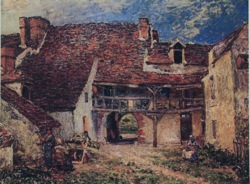 A poor picture of a Sisley painting.
A poor picture of a Sisley painting.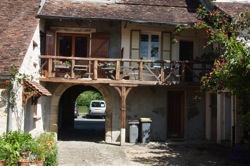 Walk into the courtyard of a building on the main street of Saint-Mammès, turn around, and here’s what you see.
Walk into the courtyard of a building on the main street of Saint-Mammès, turn around, and here’s what you see.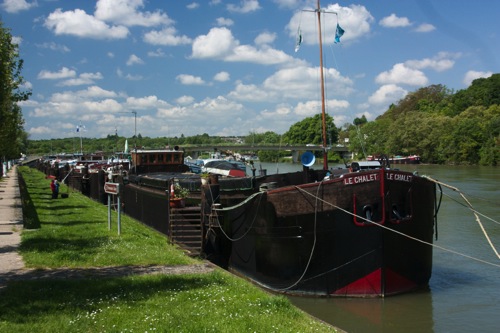 Boats on the Seine.
Boats on the Seine.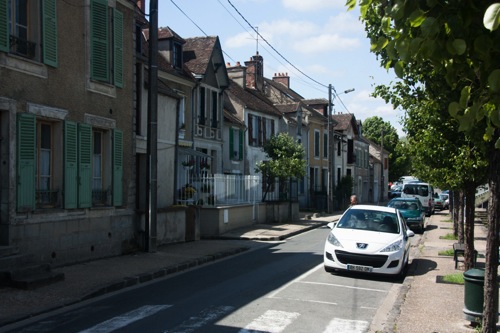 Rue du Seine in Saint-Mammès, which looks out on the Seine River.
Rue du Seine in Saint-Mammès, which looks out on the Seine River.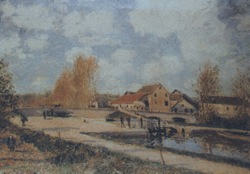
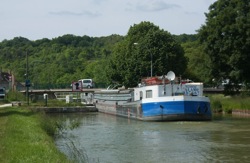
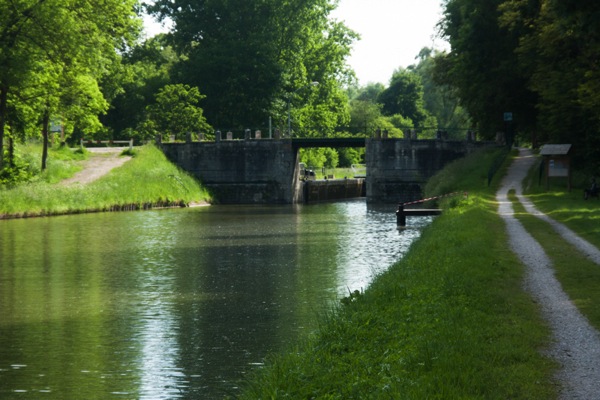
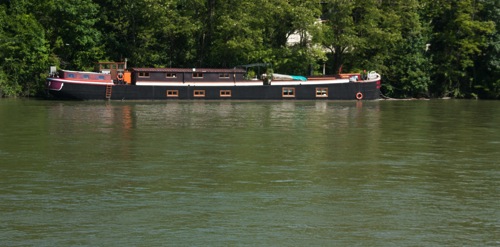
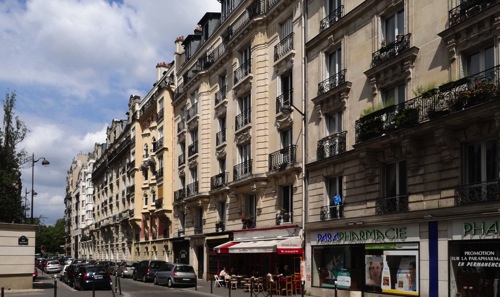
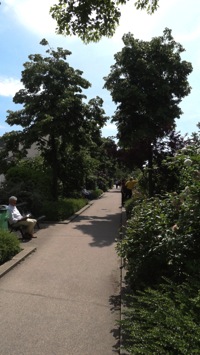 We walked along Promenade Plantée, a converted train viaduct in the middle of the 12th arrondissement. Now it’s a beautifully planted walk above the city. This offers an unusual view of Paris, as the Promenade is about 30 feet above ground level for much of its route, so you’re always looking down on streets and buildings. This was a railroad track to Bastille until the 1960s, and was converted to a promenade in the 70’s.”
We walked along Promenade Plantée, a converted train viaduct in the middle of the 12th arrondissement. Now it’s a beautifully planted walk above the city. This offers an unusual view of Paris, as the Promenade is about 30 feet above ground level for much of its route, so you’re always looking down on streets and buildings. This was a railroad track to Bastille until the 1960s, and was converted to a promenade in the 70’s.” We visited Cimetiere Picpus, an unusual cemetery. To understand it, you’ll need a tiny bit of French history. In its late stages , the French Revolution went through a pretty horrific time, known as the Terror. During this time, even the faintest suspicion of non-Revolutionary zeal – in fact, simply the accusation, true or false, of not being fully committed to the Revolution – was sufficient for a person to be tried, convicted and sent to the guillotine. Thousands were executed in Paris. In the last month of the Terror, over 1,300 people were executed in nearby Place Nation, and buried in two common graves at a convent, now the Cimetiere Picpus. Afterwards, for a reason lost to history, the only people who could be buried there were those who had ancestors who had died in the Terror.As a result, the Picpus cemetery is full of the most aristocratic names in French history. One of these is well-known to Americans: Lafayette, who came to America to fight on General Washington’s side in the American revolution. Lafayette was a hero to Americans, and to the French people for his roles in both the American Revolution and the French Revolution. He is buried in the Picpus cemetery, under soil from Bunker Hill (Boston, the first real battle of the American Revolution); his grave, and an American flag, are maintained by the Paris chapter of the Daughters of the American Revolution.
We visited Cimetiere Picpus, an unusual cemetery. To understand it, you’ll need a tiny bit of French history. In its late stages , the French Revolution went through a pretty horrific time, known as the Terror. During this time, even the faintest suspicion of non-Revolutionary zeal – in fact, simply the accusation, true or false, of not being fully committed to the Revolution – was sufficient for a person to be tried, convicted and sent to the guillotine. Thousands were executed in Paris. In the last month of the Terror, over 1,300 people were executed in nearby Place Nation, and buried in two common graves at a convent, now the Cimetiere Picpus. Afterwards, for a reason lost to history, the only people who could be buried there were those who had ancestors who had died in the Terror.As a result, the Picpus cemetery is full of the most aristocratic names in French history. One of these is well-known to Americans: Lafayette, who came to America to fight on General Washington’s side in the American revolution. Lafayette was a hero to Americans, and to the French people for his roles in both the American Revolution and the French Revolution. He is buried in the Picpus cemetery, under soil from Bunker Hill (Boston, the first real battle of the American Revolution); his grave, and an American flag, are maintained by the Paris chapter of the Daughters of the American Revolution.